A Multi-Bandwidth Reconfigurable Patch Antenna for Devices in WLAN and UWB Technology Applications
Abstract
:1. Introduction
2. Materials and Methods
2.1. Proposed Design
2.2. Development Stages
2.3. Equivalent Circuit Model of Pin Diode
- When the two PIN diodes are on, the two resonance frequencies are at GHz and GHz, with a return loss of dB and dB, respectively.
- When diode D1 is turned on and diode D2 is off, the two resonance frequencies are at GHz and GHz, with a return loss of dB and dB, respectively.
- When diode D1 is switched off and diode D2 is on, there is only one wide bandwidth of GHz impedance.
- When both diodes are turned off, the antenna does not have a band.
2.4. Parametric Study
2.5. Surface Current Distribution
3. Experimental Results and Discussion
Comparison with the State-of-the-Art WLAN and UWB Antennas
4. Conclusions
Author Contributions
Funding
Institutional Review Board Statement
Informed Consent Statement
Data Availability Statement
Acknowledgments
Conflicts of Interest
References
- Zhang, X.; Xu, H.; Xie, Y.; Wu, Q. A dual band-notched antenna for UWB applications. Prog. Electromagn. Res. Lett. 2021, 96, 105–111. [Google Scholar] [CrossRef]
- Andrews, J.G.; Buzzi, S.; Choi, W.; Hanly, S.V.; Lozano, A.; Soong, A.C.; Zhang, J.C. What will 5G be? IEEE J. Sel. Areas Commun. 2014, 32, 1065–1082. [Google Scholar] [CrossRef]
- Derneryd, A. A theoretical investigation of the rectangular microstrip antenna element. IEEE Trans. Antennas Propag. 1978, 26, 532–535. [Google Scholar] [CrossRef]
- Kara, M. Closed-form expressions for the resonant frequency of rectangular microstrip antenna elements with thick substrates. Microw. Opt. Technol. Lett. 1996, 12, 131–136. [Google Scholar] [CrossRef]
- James, J.R.; Hall, P.S. Handbook of Microstrip Antennas; IET: London, UK, 1989; Volume 1. [Google Scholar]
- Johari, S.; Jalil, M.A.; Ibrahim, S.I.; Mohammad, M.N.; Hassan, N. 28 GHz microstrip patch antennas for future 5G. J. Eng. Sci. Res. 2018, 2, 1–6. [Google Scholar]
- Mungur, D.; Duraikannan, S. Microstrip patch antenna at 28 GHz for 5G applications. J. Sci. Technol. Eng.-Manag.-Adv. Res. Innov. 2018, 1, 20–22. [Google Scholar]
- Kenane, E.; Bakhti, H.; Bentoumi, M.; Djahli, F. A Dynamic Invasive Weeds Optimization Applied to Null Control of Linear Antenna Arrays with Constrained DRR. Adv. Electromagn. 2021, 10, 52–61. [Google Scholar] [CrossRef]
- Bikrat, M.; Bri, S. Multiband Reconfigurable Planar Antenna for Wireless Mobile Communications. In Proceedings of the International Conference on Digital Technologies and Applications, Fez, Morocco, 27–28 January 2023; Springer: Berlin/Heidelberg, Germany, 2023; pp. 279–288. [Google Scholar]
- Deffenbaugh, P.I.; Rumpf, R.C.; Church, K.H. Broadband microwave frequency characterization of 3-D printed materials. IEEE Trans. Compon. Packag. Manuf. Technol. 2013, 3, 2147–2155. [Google Scholar] [CrossRef]
- Liang, M.; Shemelya, C.; MacDonald, E.; Wicker, R.; Xin, H. 3-D printed microwave patch antenna via fused deposition method and ultrasonic wire mesh embedding technique. IEEE Antennas Wirel. Propag. Lett. 2015, 14, 1346–1349. [Google Scholar] [CrossRef]
- Hester, J.G.; Kim, S.; Bito, J.; Le, T.; Kimionis, J.; Revier, D.; Saintsing, C.; Su, W.; Tehrani, B.; Traille, A.; et al. Additively manufactured nanotechnology and origami-enabled flexible microwave electronics. Proc. IEEE 2015, 103, 583–606. [Google Scholar] [CrossRef]
- Palud, S.; Colombel, F.; Himdi, M.; Le Meins, C. Wideband omnidirectional and compact antenna for VHF/UHF band. IEEE Antennas Wirel. Propag. Lett. 2011, 10, 3–6. [Google Scholar] [CrossRef]
- Stutzman, W.L.; Thiele, G.A. Antenna Theory and Design; John Wiley & Sons: Berlin/Heidelberg, Germany, 2012. [Google Scholar]
- Bikrat, M.; Bri, S. Reconfigurable circularly polarized antenna for WLAN and WIMAX. Int. J. Adv. Trends Comput. Sci. Eng 2020, 9, 46–52. [Google Scholar] [CrossRef]
- Nakano, H.; Morishita, K.; Yamauchi, J. Extremely Wide-Band, Low-Profile BOR-SPR Antenna. In Proceedings of the 2008 International Workshop on Antenna Technology: Small Antennas and Novel Metamaterials, White Plains, NY, USA, 6–8 March 2006; IEEE: Picataway, NJ, USA, 2008; pp. 20–23. [Google Scholar]
- Bikrat Mohamed, B.S. Design of an Inclined Fractal Defected Ground-Based Polarized Antenna for WLAN Applications. Int. J. Microw. Opt. Technol. (IJMOT) 2021, 16, 311–318. [Google Scholar]
- Ali, W.A.; Ashraf, M.I.; Salamin, M.A. A dual-mode double-sided 4 × 4 MIMO slot antenna with distinct isolation for WLAN/WiMAX applications. Microsyst. Technol. 2021, 27, 967–983. [Google Scholar] [CrossRef]
- Khan, Z.; Memon, M.H.; Rahman, S.U.; Sajjad, M.; Lin, F.; Sun, L. A single-fed multiband antenna for WLAN and 5G applications. Sensors 2020, 20, 6332. [Google Scholar] [CrossRef]
- Ajewole, B.; Kumar, P.; Afullo, T. A Microstrip Antenna Using I-Shaped Metamaterial Superstrate with Enhanced Gain for Multiband Wireless Systems. Micromachines 2023, 14, 412. [Google Scholar] [CrossRef] [PubMed]
- Oh, Z.X.; Yeap, K.H.; Voon, C.S.; Lai, K.C.; Teh, P.C. A multiband antenna for biomedical telemetry and treatments. In Journal of Physics: Conference Series; IOP Publishing: Bristol, UK, 2020; pp. 12013–12026. [Google Scholar]
- Dumoulin, A.; John, M.; Ammann, M.J.; McEvoy, P. Optimized monopole and dipole antennas for UWB asset tag location systems. IEEE Trans. Antennas Propag. 2012, 60, 2896–2904. [Google Scholar] [CrossRef]
- Gao, G.P.; Hu, B.; Wang, S.F.; Yang, C. Wearable circular ring slot antenna with EBG structure for wireless body area network. IEEE Antennas Wirel. Propag. Lett. 2018, 17, 434–437. [Google Scholar] [CrossRef]
- Islam, M.T.; Islam, M.M.; Samsuzzaman, M.; Faruque, M.R.I.; Misran, N. A negative index metamaterial-inspired UWB antenna with an integration of complementary SRR and CLS unit cells for microwave imaging sensor applications. Sensors 2015, 15, 11601–11627. [Google Scholar] [CrossRef] [PubMed]
- Kang, C.H.; Wu, S.J.; Tarng, J.H. A novel folded UWB antenna for wireless body area network. IEEE Trans. Antennas Propag. 2011, 60, 1139–1142. [Google Scholar] [CrossRef]
- Alam, M.J.; Faruque, M.; Islam, M. Split quadrilateral multiband microstrip patch antenna design for modern communication system. Microw. Opt. Technol. Lett. 2017, 59, 1530–1538. [Google Scholar] [CrossRef]
- Ramos, A.; Lazaro, A.; Girbau, D.; Villarino, R. RFID and Wireless Sensors Using Ultra-Wideband Technology; Elsevier: Amsterdam, The Netherlands, 2016. [Google Scholar]
- Nella, A.; Gandhi, A. Lumped equivalent models of narrowband antennas and isolation enhancement in a three antennas system. Radioengineering 2018, 27, 646–653. [Google Scholar]
- Awan, W.A.; Hussain, N.; Ghaffar, A.; Zaidi, A.; Naqvi, S.I.; Li, X.J. Compact flexible frequency reconfigurable antenna for heterogeneous applications. In Proceedings of the 2020 9th Asia-Pacific Conference on Antennas and Propagation (APCAP), Xiamen, China, 4–7 August 2020; IEEE: Picataway, NJ, USA, 2020; pp. 1–2. [Google Scholar]
- Biswas, B.; Ghatak, R.; Poddar, D. A fern fractal leaf inspired wideband antipodal Vivaldi antenna for microwave imaging system. IEEE Trans. Antennas Propag. 2017, 65, 6126–6129. [Google Scholar] [CrossRef]
- Bikrat, M.; Bri, S. A Bandwidth Reconfigurable Planar Antenna for UWB-Applications. In E3S Web of Conferences; EDP Sciences: Les Ulis, France, 2022; Volume 351, pp. 1060–1065. [Google Scholar]
- Nie, L.Y.; Lin, X.Q.; Yang, Z.Q.; Zhang, J.; Wang, B. Structure-shared planar UWB MIMO antenna with high isolation for mobile platform. IEEE Trans. Antennas Propag. 2018, 67, 2735–2738. [Google Scholar] [CrossRef]
- Bikrat, M.; Bri, S. A bandwidth reconfigurable antenna for devices in low UWB-applications. TELKOMNIKA (Telecommun. Comput. Electron. Control) 2023, 21, 272–279. [Google Scholar] [CrossRef]
- Marzouk, M.; Nejdi, I.H.; Rhazi, Y.; Saih, M. Multiband and Wide Band Octagonal Fractal Antenna for Telecommunication Applications. In Proceedings of the 2022 8th International Conference on Optimization and Applications (ICOA), Sestri Levante, Italy, 6–7 October 2022; IEEE: Pitcataway, NJ, USA, 2022; pp. 1–6. [Google Scholar]
- Reis, P.; Virani, H. Design of a compact microstrip patch antenna of FR-4 substrate for wireless applications. In Proceedings of the 2020 International Conference on Electronics and Sustainable Communication Systems (ICESC), Coimbatore, India, 2–4 July 2020; IEEE: Pitcataway, NJ, USA, 2020; pp. 713–716. [Google Scholar]
- Ngan, V.H.; Danh, L.V.Q. Design of a loop patch antenna system with improved bandwidth for 2.4-GHz WLAN applications. In Proceedings of the 2015 2nd National Foundation for Science and Technology Development Conference on Information and Computer Science (NICS), Ho Chi Minh City, Vietnam, 16–18 September 2015; IEEE: Piscataway, NJ, USA, 2015; pp. 105–109. [Google Scholar]
- Devi, R.; Neog, D. Determination of Radius of Circular Microstrip Antenna Using Clonal Selection Algorithm. IOSR J. Electron. Commun. Eng. Ver. I 2015, 10, 2278–2834. [Google Scholar]
- Balanis, C.A. Antenna Theory: Analysis and Design; John Wiley & Sons: Hoboken, NJ, USA, 2016. [Google Scholar]
- Attalhaoui, A.; Bendali, A.; Wardi, A.R.E.; Habibi, M. Dual linear polarization reconfigurable patch antennas for lower 5G frequency band. J. Theor. Appl. Inf. Technol. 2021, 99, 4725–4734. [Google Scholar]
- Deepa, M.; Reba, P.; Annalakshmi, H.; Suthindhira, S. Design and Fabrication of Dual band Slotted Microstrip Patch Antenna-3.5 GHz and 2.4 GHz. In Proceedings of the 2023 International Conference on Intelligent Systems for Communication, IoT and Security (ICISCoIS), Kerala, India, 6–7 July 2023; IEEE: Picataway, NJ, USA, 2023; pp. 208–211. [Google Scholar]
- Zhang, E.; Michel, A.; Pino, M.R.; Nepa, P.; Qiu, J. A dual circularly polarized patch antenna with high isolation for MIMO WLAN applications. IEEE Access 2020, 8, 117833–117840. [Google Scholar] [CrossRef]
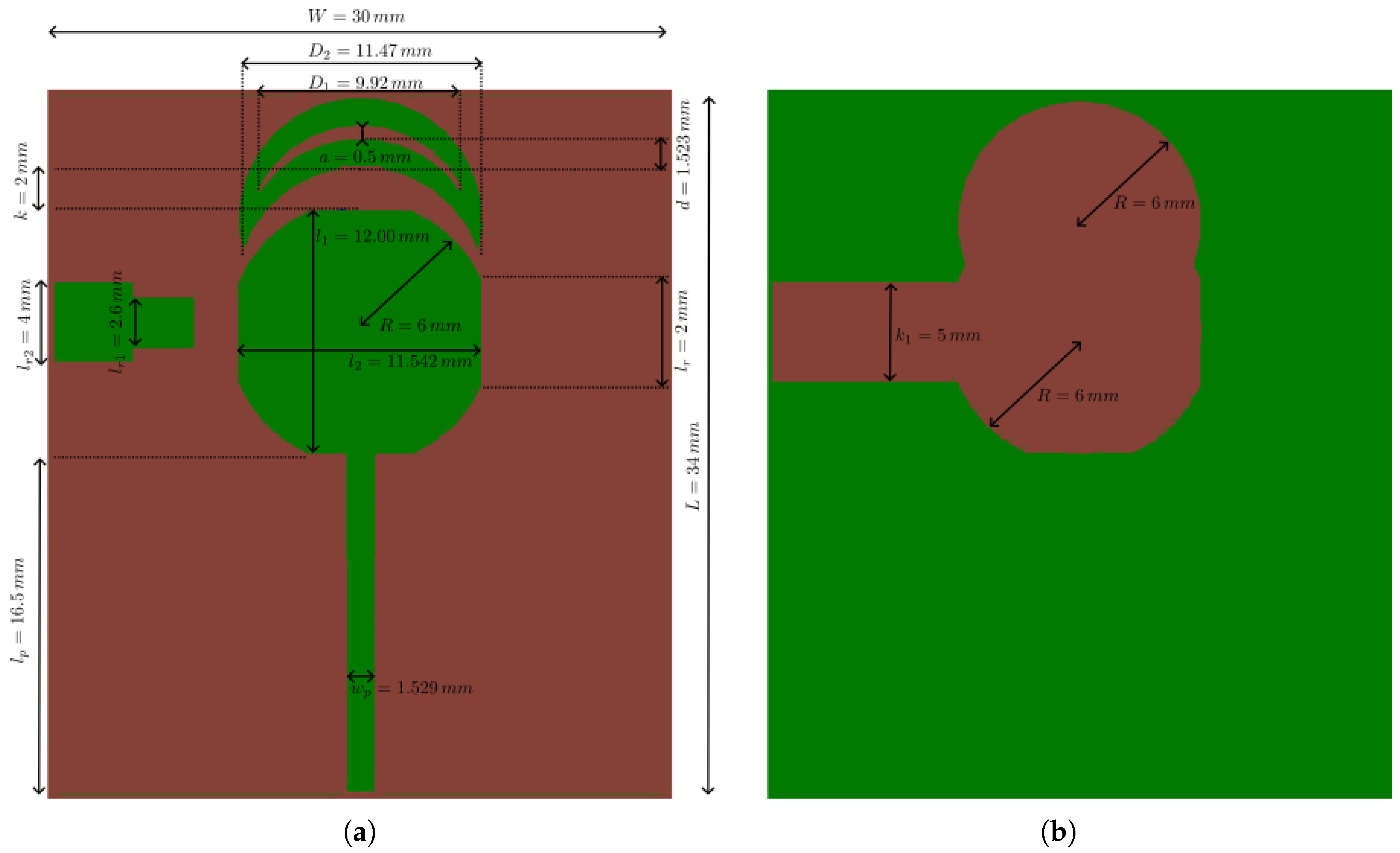
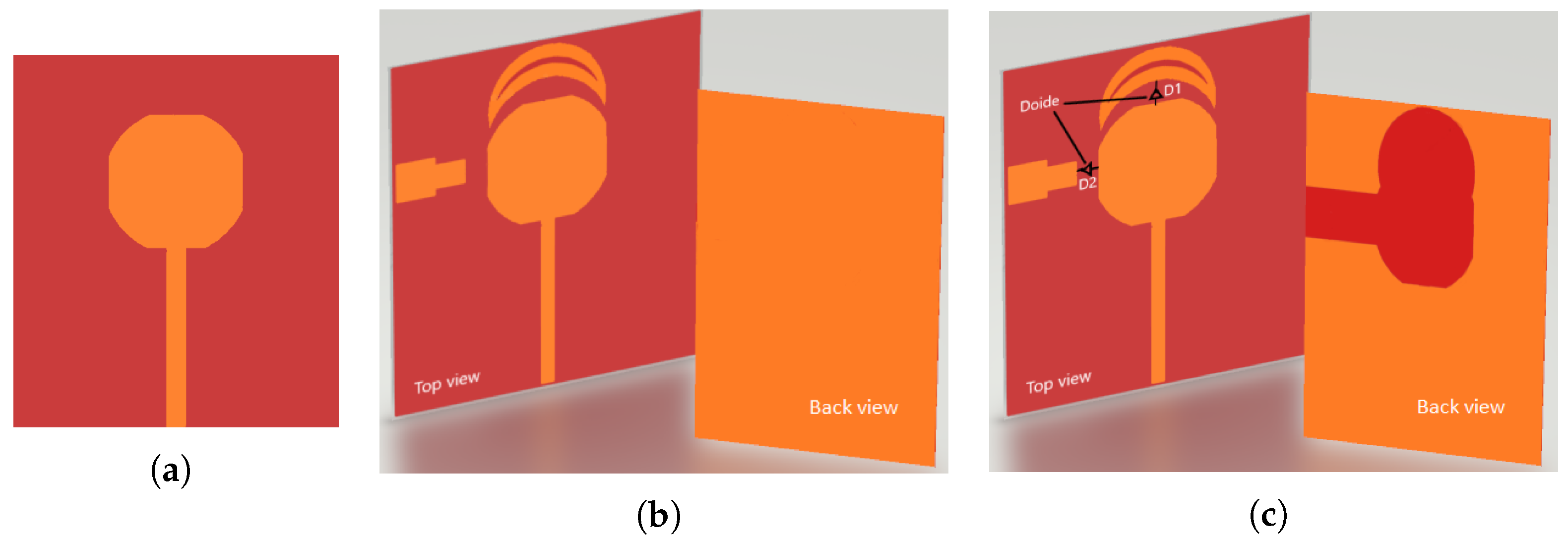
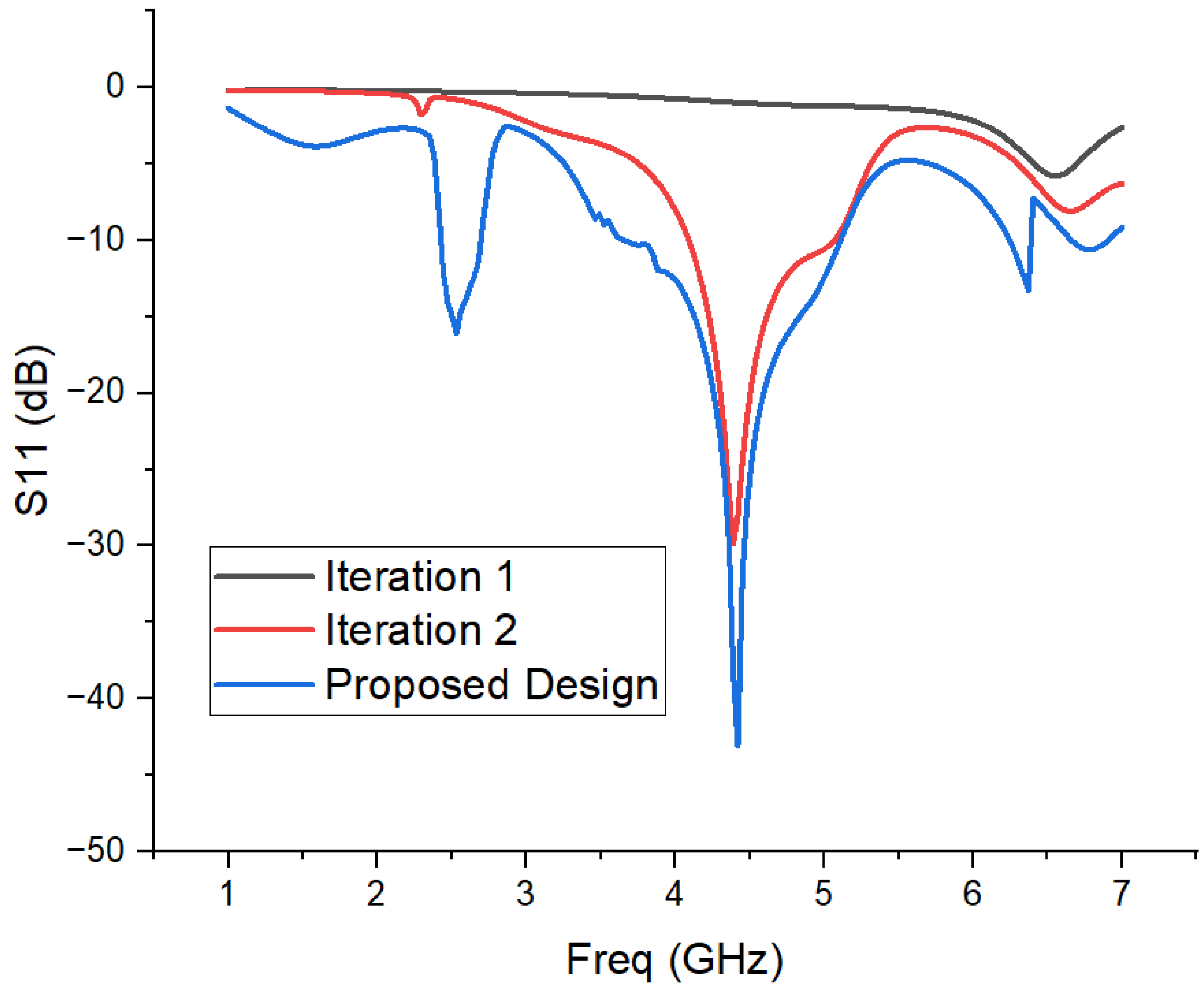

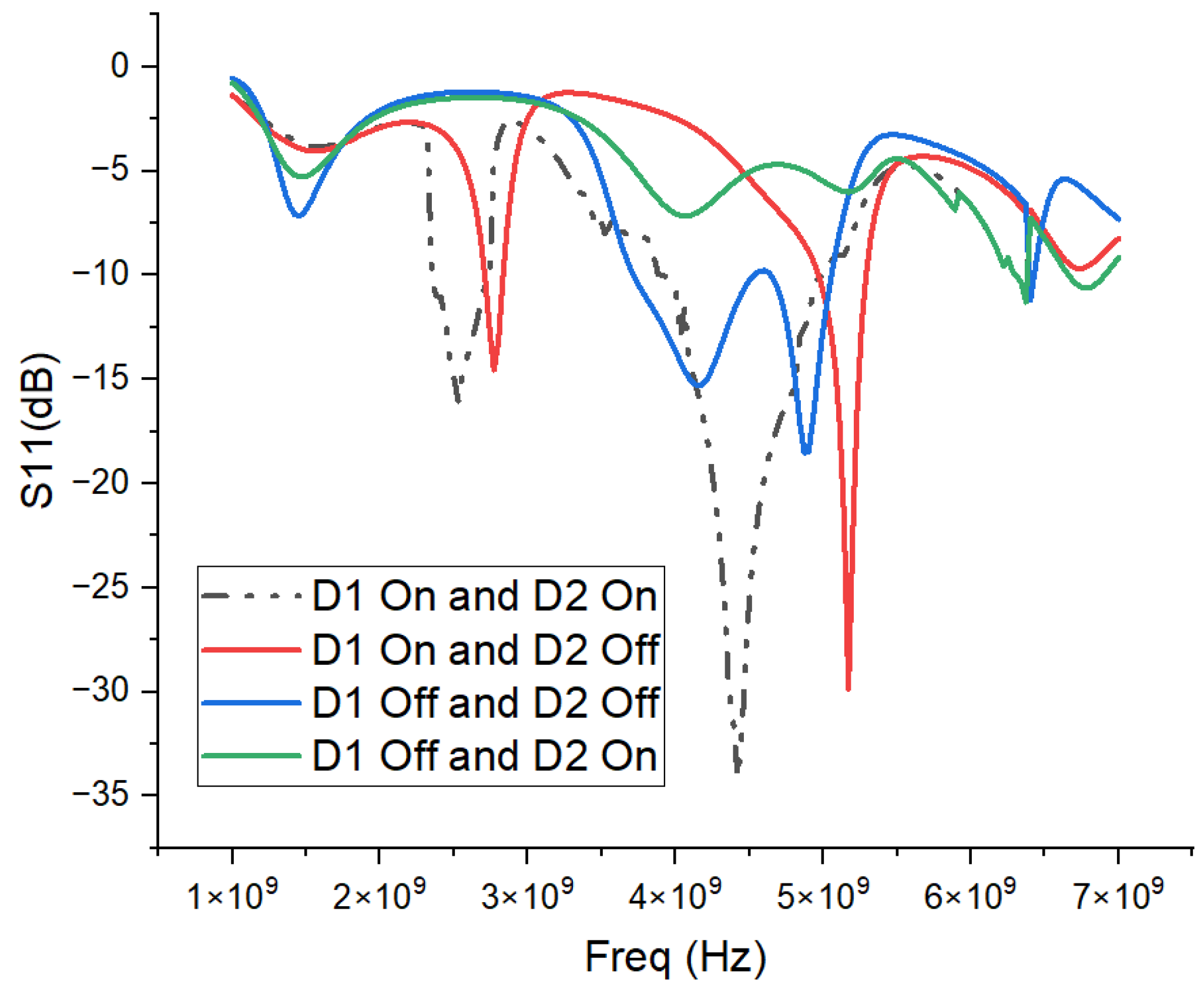
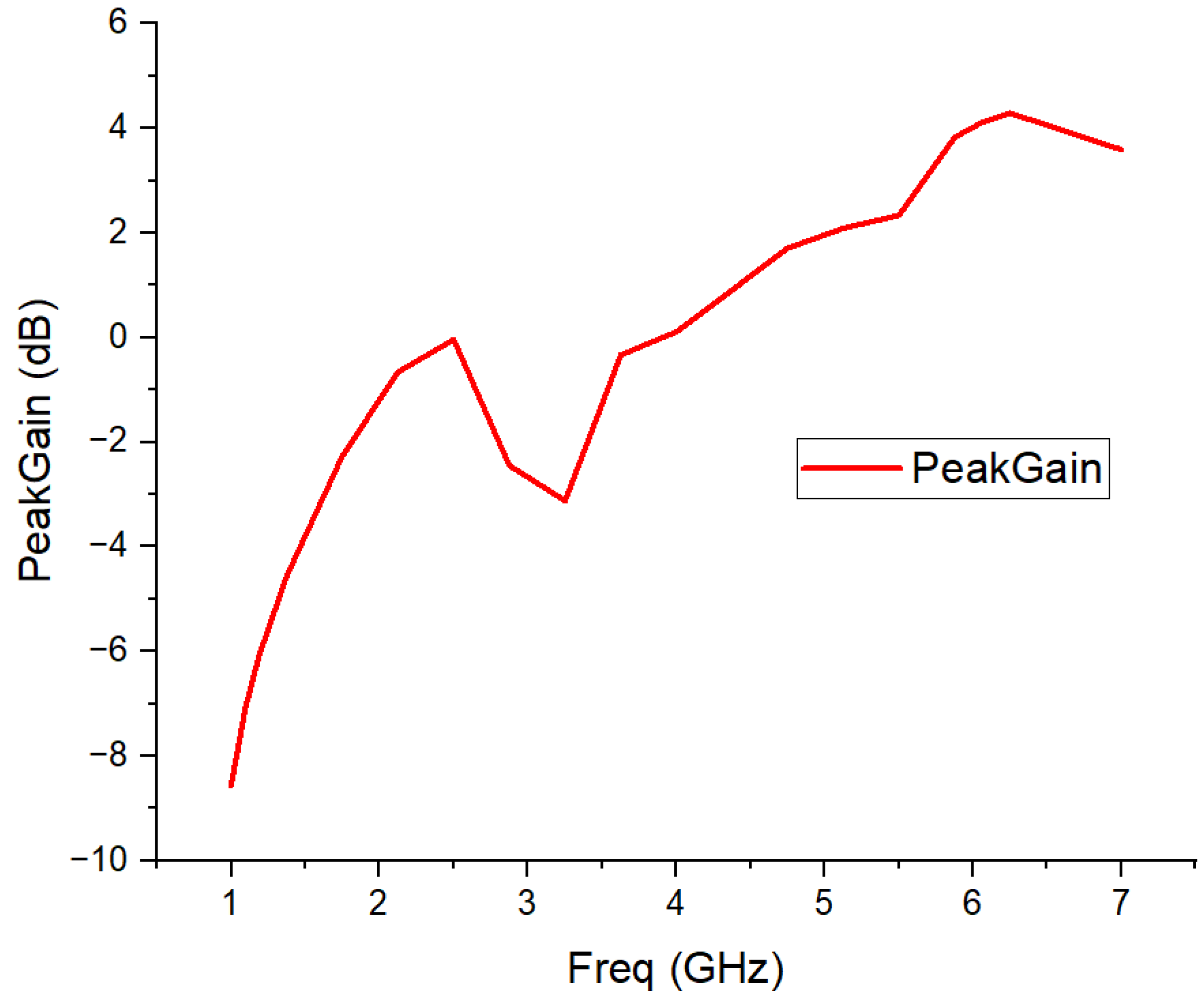
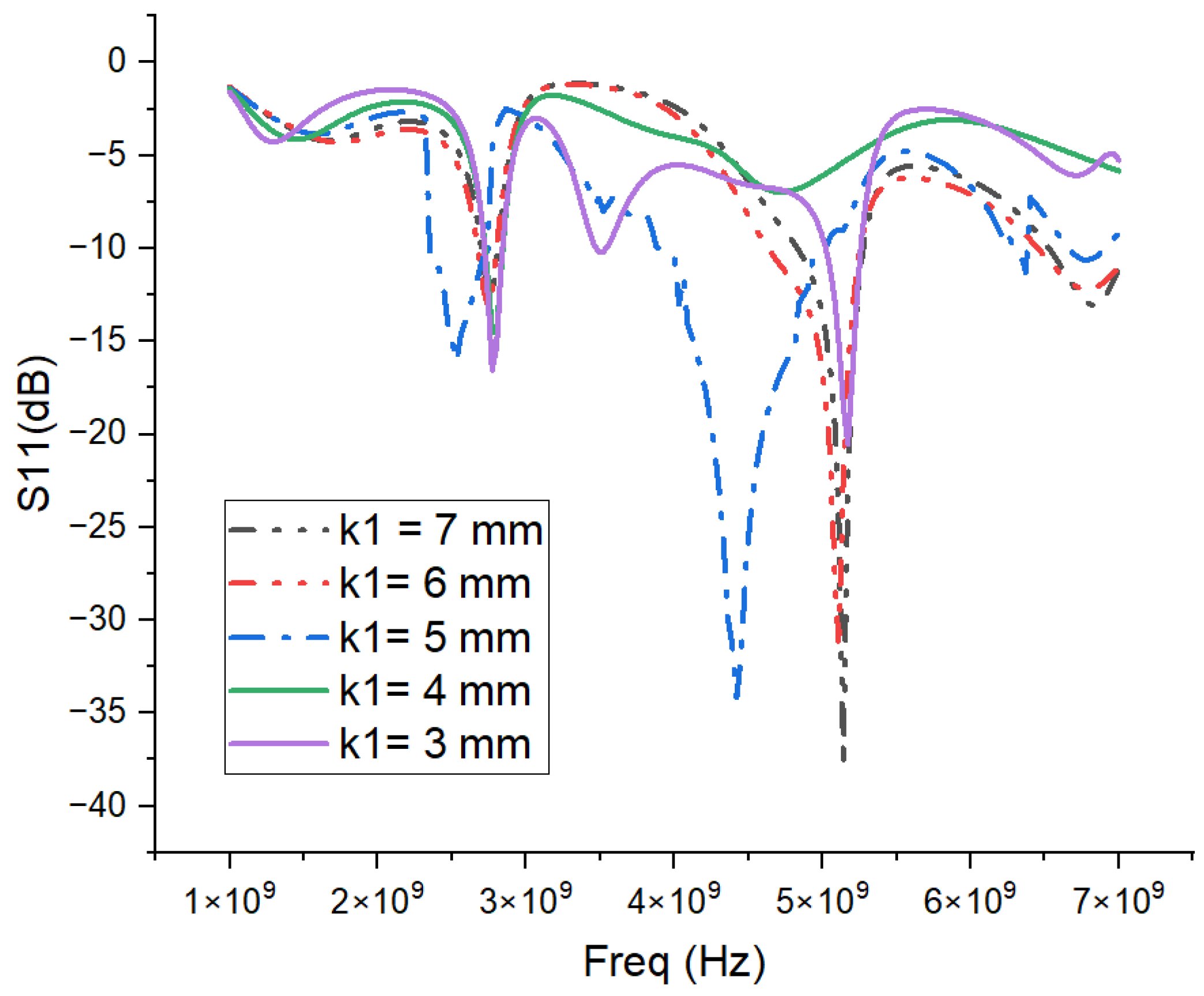

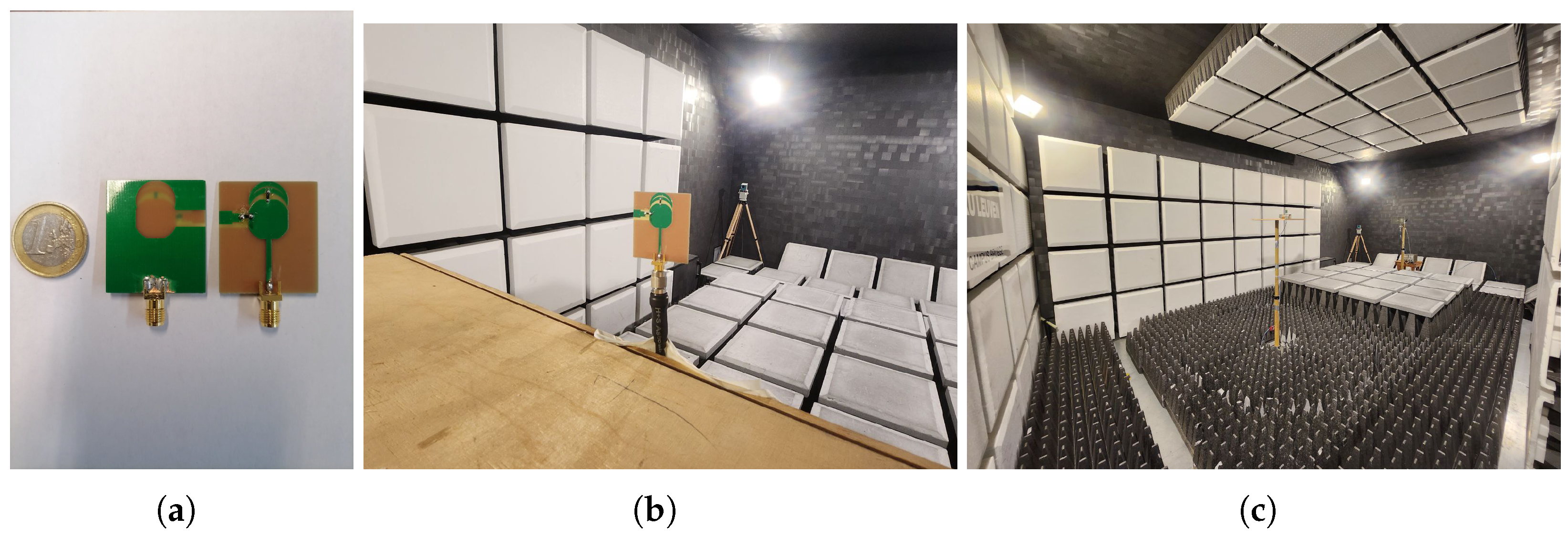
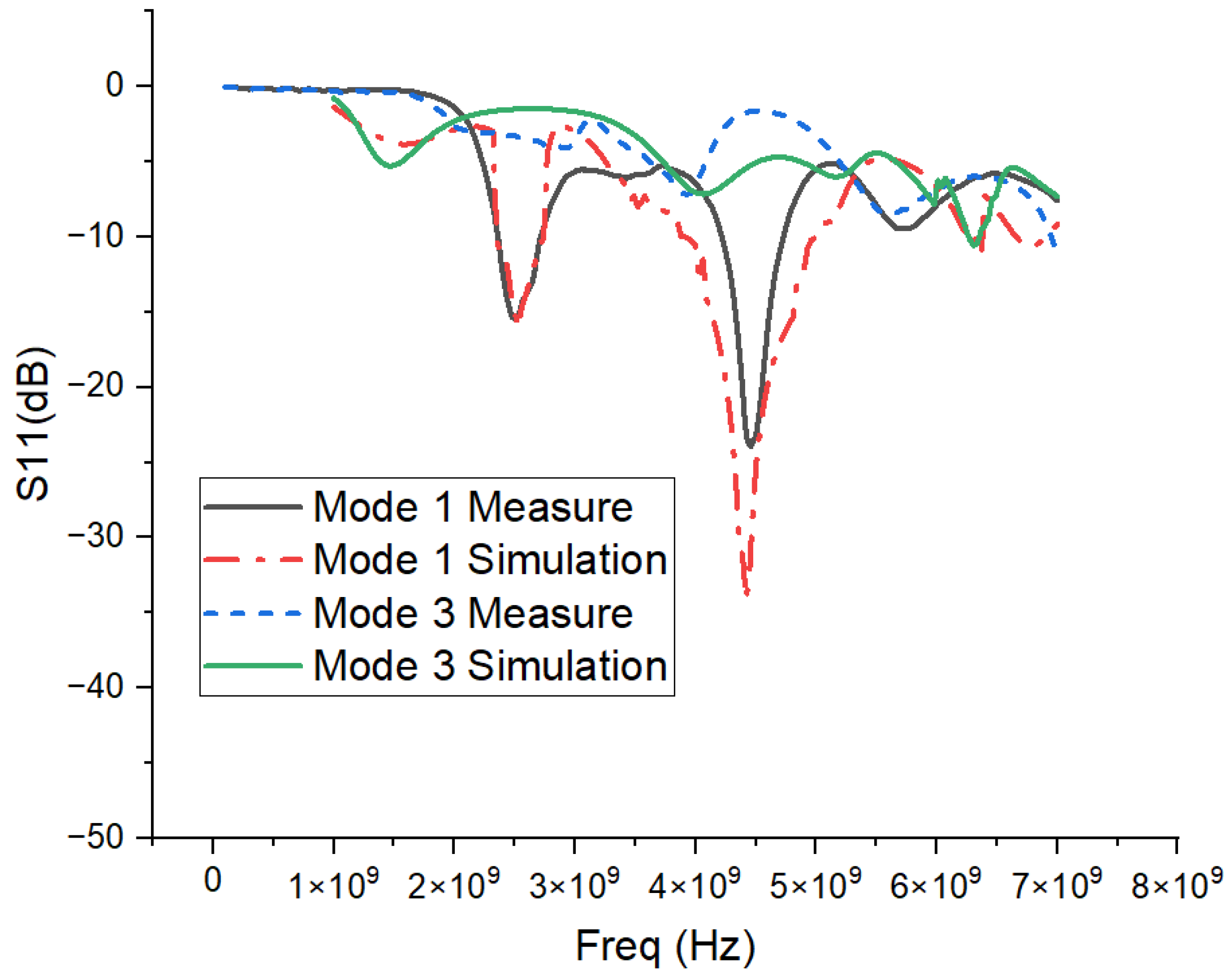
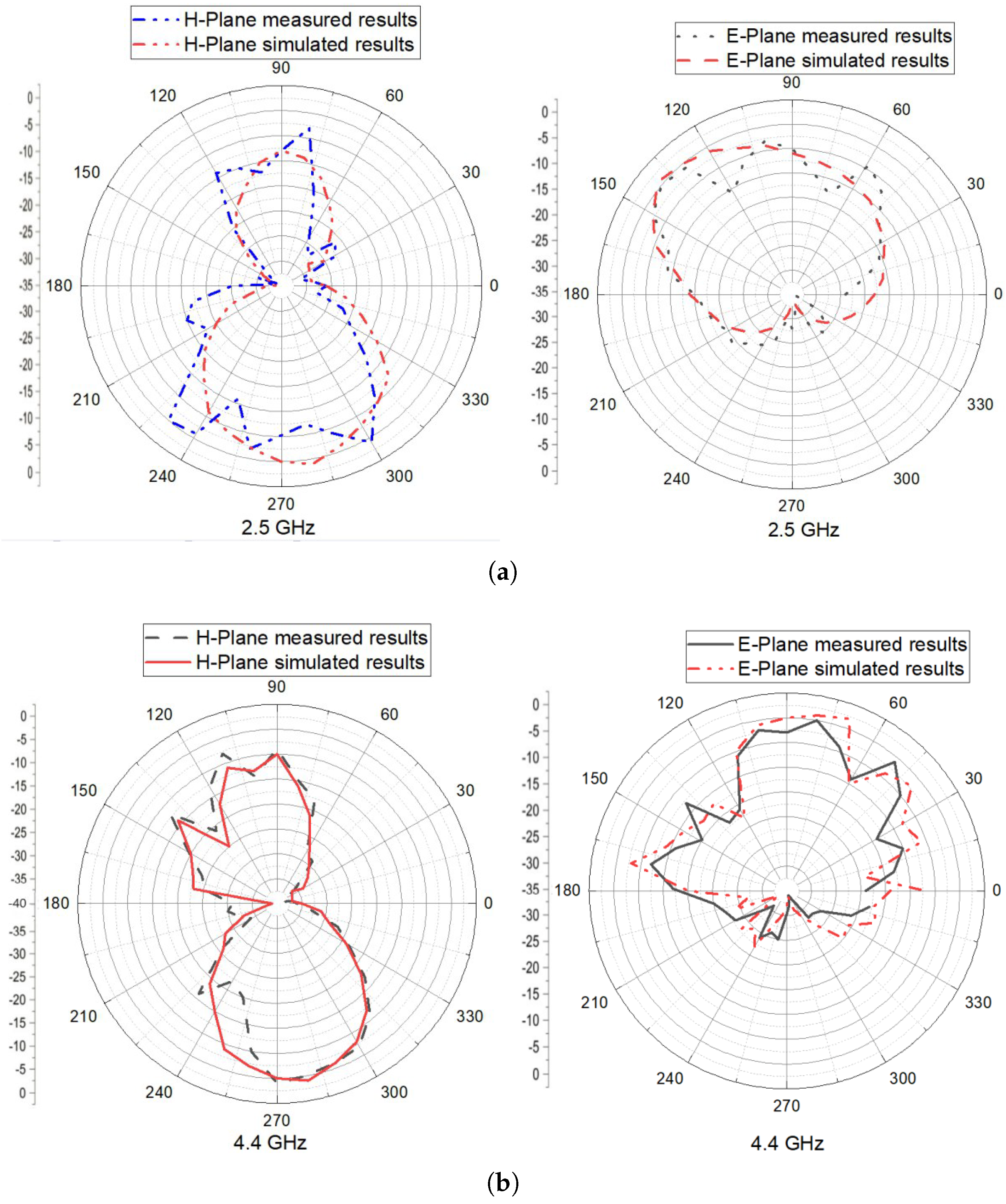
| Dimension | Size (mm) | Dimension | Size (mm) | Dimension | Size (mm) |
|---|---|---|---|---|---|
| h | 3 | W | 30 | ||
| K | 2 | ||||
| 4 | R | 6 | |||
| 12 | a | ||||
| 2 | d |
Disclaimer/Publisher’s Note: The statements, opinions and data contained in all publications are solely those of the individual author(s) and contributor(s) and not of MDPI and/or the editor(s). MDPI and/or the editor(s) disclaim responsibility for any injury to people or property resulting from any ideas, methods, instructions or products referred to in the content. |
© 2023 by the authors. Licensee MDPI, Basel, Switzerland. This article is an open access article distributed under the terms and conditions of the Creative Commons Attribution (CC BY) license (https://creativecommons.org/licenses/by/4.0/).
Share and Cite
Bikrat, M.; Bri, S.; Bravo, A.G.; Manterola, A.M.; Gonzalez-Atienza, M.; Amador, F. A Multi-Bandwidth Reconfigurable Patch Antenna for Devices in WLAN and UWB Technology Applications. Appl. Sci. 2023, 13, 9367. https://doi.org/10.3390/app13169367
Bikrat M, Bri S, Bravo AG, Manterola AM, Gonzalez-Atienza M, Amador F. A Multi-Bandwidth Reconfigurable Patch Antenna for Devices in WLAN and UWB Technology Applications. Applied Sciences. 2023; 13(16):9367. https://doi.org/10.3390/app13169367
Chicago/Turabian StyleBikrat, Mohamed, Seddik Bri, Alberto Gascón Bravo, Alejandro Muñoz Manterola, Miriam Gonzalez-Atienza, and Farah Amador. 2023. "A Multi-Bandwidth Reconfigurable Patch Antenna for Devices in WLAN and UWB Technology Applications" Applied Sciences 13, no. 16: 9367. https://doi.org/10.3390/app13169367
APA StyleBikrat, M., Bri, S., Bravo, A. G., Manterola, A. M., Gonzalez-Atienza, M., & Amador, F. (2023). A Multi-Bandwidth Reconfigurable Patch Antenna for Devices in WLAN and UWB Technology Applications. Applied Sciences, 13(16), 9367. https://doi.org/10.3390/app13169367






